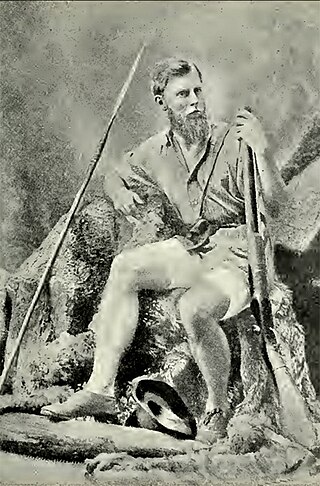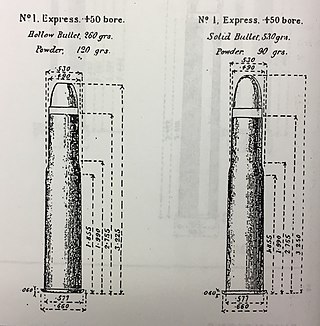
The .303 British or 7.7×56mmR, is a .303-inch (7.7 mm) calibre rimmed tapered rifle cartridge. The .303 inch bore diameter is measured between rifling lands as is the common practice in Europe which follows the traditional black powder convention.
The .600 Nitro Express (15.7x76mmR) is a large bore Nitro Express rifle cartridge developed by W.J. Jeffery & Co for the purpose of hunting large game.
The .577 Nitro Express is a large-bore centerfire rifle cartridge designed for the purpose of hunting large game such as elephant. This cartridge is used almost exclusively in single-shot and double express rifles for hunting in the Tropics or hot climates in general and is a cartridge associated with the golden age of African safaris and Indian shikars.
The Austro-Hungarian 8×50mmR Mannlicher or 8×50mmR M93 is a service cartridge dating back to the days of semi-smokeless powder. It was later replaced by the 8×56mmR cartridge.
The .475 No 2 Nitro Express is a British rifle cartridge developed by Eley Brothers in the early 20th century.

Four bore or 4 bore is a black powder caliber of the 19th century, used for the hunting of large and potentially dangerous game animals. The specifications place this caliber between the larger 2 bore and the smaller 6 bore rifles. This caliber was the quintessential elephant gun caliber of the black powder safari rifles. The caliber was also used for the Coffman cartridges used for starting large aero engines such as the Rolls-Royce Griffon as used in the later Marks of Supermarine Spitfire.
The 6 bore, also known as the 6 gauge, is an obsolete caliber that was used commonly in 19th-century black-powder firearms.

The .500 Nitro Express / 13x76mmR is a rifle cartridge designed for hunting large and dangerous game animals in Africa and India. This cartridge was primarily designed for use in double rifles though various single shots were produced on the Farquarson action and at least one major company (Heym) produced it in bolt-action configuration. It was commonly available in two lengths: a 3.00 in (76 mm) and a 3.25 in (83 mm) version.
The .400 Jeffery Nitro Express or .450/400 Nitro Express 3-inch is a medium bore, bottlenecked, Nitro Express cartridge designed by W.J. Jeffery & Co in 1902, intended for use in single shot and double rifles.

The .318 Westley Richards, also known as the .318 Rimless Nitro Express and the .318 Accelerated Express, is a proprietary medium bore centerfire rifle cartridge developed by Westley Richards.
The .369 Nitro Express, also known as the .369 Purdey Nitro Express, is a centerfire, rifle cartridge developed by James Purdey & Sons and introduced in 1922.
The .450 Black Powder Express, also known as the .450 31⁄4-inch BPE, was a popular black powder cartridge in the late 19th and early 20th century.

The .255 Jeffery Rook / 6.5x29mmR, also known as the .255 Jeffery Rook Rifle, is an obsolete small bore intermediate firearm cartridge.
The .400 Purdey, also known as the .400 3-inch Straight and .400 Purdey Light Express 3-inch, is an obsolete rifle cartridge developed by James Purdey & Sons.

The .300 Rook / 7.6x30mmR, also known as the .295 Rook, is an obsolete intermediate centerfire rifle cartridge.
The .400/360 Nitro Express cartridges are a number of very similar, but not interchangeable, centerfire rifle cartridges developed by James Purdey & Sons, William Evans, Westley Richards and Fraser of Edinburgh, all at the beginning of the 20th century.
The .360 No. 2 Nitro Express is a centerfire rifle cartridge developed by Eley Brothers and introduced in 1905.

The .500/450 No. 1 Black Powder Express, known in its day as the .500/450 No. 1 Express, was a centerfire rifle cartridge developed by Westley Richards and introduced in the late 1870s.

The .297/230 Morris Short and .297/230 Morris Long are two obsolete centerfire firearm cartridges developed as sub-caliber training rounds for the British Martini–Henry rifle.
The 20/577 Alexander Henry, also known as 20/577 Express, is an obsolete rifle cartridge.









